& Company
DAD'S TRUCK
A Boy's Adventure in the Icebox Era
by Matthew-Daniel Stremba
Mom and Dad came from the "coal region"—the easy term used back then in eastern Pennsylvania when referring to those counties northeast of the state capital where the major industry was anthracite mining. Mary Wochok grew up in St. Clair, and John Stremba in Mahanoy City, two small towns where many of "their kind"—arriving in the USA in waves since the late 1800s—had been settling, making a life, and building their distinctive churches.
The coal and railroad barons were Protestants with English and Scottish surnames. Their labor force early on numbered many Welsh who quickly moved into mine-boss positions. The Irish, after they got through their Molly McGuire phase, were soon the next generation of supervisors and foremen. The Slavs, however—immigrants from the Austro-Hungarian Empire, mostly Greek Catholic or, in time, Eastern Orthodox—found advancement only, by and large outside the mines.
Hryhory, my Mom's father, from the Boyko forests and meadows of the Carpathian mountains, spent all his American years swinging a mallet deep down in the dark of Schuylkill County's geologic foundations. Andrew, my Dad's father, from the Magyarized side of the Carpathians, disdained such work and took advantage of American opportunity trying his hand at a series of businesses, the longest run—a butcher shop operated in the ground floor of the family home. Other Slavic males with upward ambition opened saloons.
Dad put real distance between himself and the mining option not just by following his father's meat-cutting model but also in moving with his bride to Reading PA, forty miles away from any veins of anthracite. Coal's only importance in Reading [pronounced Red-ding] was in your cellar bin. (In those days you hand-fed the furnace that cooked the water that boiled up into the radiators upstairs without benefit of an electric circulator.) Dad's brother Julius, however, not only opted for mine work, but even, like their Uncle John (who in old photos looks like some Mafia don), became a union organizer.
The home I grew up in was situated in Reading's older side. "South of Penn" normally meant something like "the wrong side of the tracks." In fact, when you came out the front door of our house, number 636, the oldest brick structure on the block, and looked right up Bingaman Street, you'd see a stone bridge crossing our street, carrying the main line of the old Reading Railroad, built in the generation leading up to the Civil War on just the right grade descending from St Clair to Philadelphia to carry tons of coal without having to burn too much in transit. I loved living near the railroad—the peculiar smell and sounds of steam locomotives chugged like no other through a boy's soul.
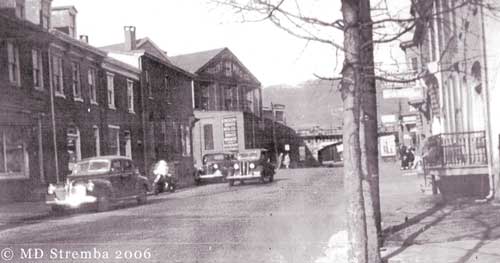
1940s Bingaman Street, but after WWII, looking east toward Reading RR overpass.
And in all those years we walked everywhere. To church: two blocks south towards the Schuylkill River. To school: two blocks west to Tyson-Schoener, four blocks to Southwest Junior High. Uptown: four-five blocks to Penn Street, Pomeroy's, Kresge's, movie houses, the post office, courthouse, city hall. Or to Schlegel Park, or Wyomissing Park, way on the other side of the river. There was a bicycle or two, but never a family car.
When my brother, John Jr, not long after his high-school graduation, purchased a used 1951 Dodge—four-doors, black, lots of chrome—it was an event, not just for the family but for the whole block. One of the Farina sons owned a 1948 Oldsmobile equipped with hydromatic drive. And Mr.and Mrs. Kubacki drove a respectable Dodge sedan that they parked in a garage! But that was about it. Traffic was light.
But my father did indeed drive. I have no idea when he got his first license. I only remember him driving a Chevy truck home for lunch. It was Charlie Delp's truck. Delp owned a meat store at the northeastern end of the city, where Dad worked most of his adult years. He may have been the first Slav to set foot in that territory. If Delp's clientele included any Catholics, they would've been of the Germanic variety—long settled in Pennsylvania, their parish church sprawling large two blocks north of Penn.
That Chevy was a panel truck—a bit larger than today's SUVs—specially outfitted with a meat case accessible from the rear. When Dad came home for lunch, the meat was all gone, not even any melting ice, just the faint smell of blood and bleach. He had spent the morning on a route that wound among fine homes and big row houses far from the river and where the railroad was not visible. Regular customers would come out on the street to look at what Delp's had to offer. One of many route sales that were built on a society for whom the personal car was not yet king.
All these regular customers were women, the housewives at home, some of whom flirted—for my father in his brimmed hat and bloodied apron, especially when showing sides of beef or cuts of pork, was a charmer. The A&P and Acme in those days were simply corner-store franchises, no bigger than Charlie Delp's establishment. The lady of the house would request such and such cut and watch Dad do the surgery, then trusted him to tally it right and debit their account correctly in The Book.
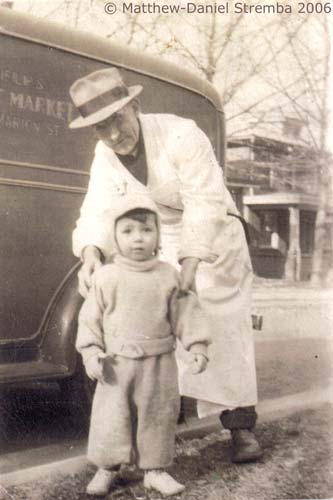
This snapshot is all that is left of one mother's trying out her new box camera one day in the 1940s. That this north-of-Penn lady wanted a photo of her child with their meat cutter posed in front of Delp's truck says something not only about that era, but also about John Stremba Sr, the person. Here he is in his usual hat, but the butcher's outfit is all bunched up. He seems to be keeping the child clean from contact with any beef blood on his apron. How many pounds of sirloin did the picture-snapping lady buy that day?
When Dad came home for lunch, he'd be somewhat tuckered, having begun the workday before dawn. After a hot meal that Mom served him (she too was an at-home housewife, though she longed to go into the job market), he'd go upstairs for a short nap, before returning to work.
It was during one of those short naps that my brother John slipped my father's keys off the table without Mom noticing. I'm estimating this happened not long after the end of WWII, years before John would become the owner of that 1951 Dodge, years before the age to be eligible for a license. It must've been summer, because young John was not at school and, besides, his objective (a main theme of this story) was to get a fresh block of ice—obviously a frequent need in warmer months. In the winter I think we pretty much made do with a window box to store perishables.
The ice-plant was up on South Ninth Street, six to seven blocks away, and the usual way to do this chore was to trudge up there pulling along an empty red wagon, the same wagon John used on Saturdays to haul groceries from the Bingaman Street Market-house to shoppers' homes, earning for his services a nickel or, when the shopper felt particularly generous, 15 cents. But here it was, the ice chore, and there's this idle truck available. And—wouldn't that be fun! And educational, too. Those few times John had accompanied some driver, he used to watch with close attention as the man depressed the clutch and shifted gears, feeling the coordination between the speed of the car and the tempo of letting go the pedal. It was time to put that mental learning into practice. And that's what he had in mind.
He got that truck started—the thing shuddering away from the curb and creeping down the street, a left southwards, then east on Laurel, and just past Seventh shift down for a climb up to Ninth—putt-putt-putt-putt-putt—then a right turn, and pass through the thick aroma of the Old Reading Brewery, and—there!—pull in, put the thing into reverse, and back it up to the Reading Ice Company loading area. The guys on the loading dock squint as if asking themselves, "isn't this the kid with a red wagon?"
When John lugged that block of ice into our home, his fingers and thumbs numb-cold in the warm kitchen, Mom was surprised he got back so soon. And Dad, refreshed from his nap, found his keys right where he had left them, and was off to go back up north to Delp's, not coming home till after sunset.
Theresa and Elaine, my sisters, had witnessed John's bold departure and return by truck, but kept a good-sisters' silence about the adventure until much later. Mom's first knowledge of the story produced the usual parental groans, then head shaking with tsk-tsk-ing, and in later years some helpless laughter at the memory of it all. I don't know when I began hearing this story, but Dad died some forty years after that episode and he'd never—as far as I know—he'd never come to know about it.
These days, all these years later, John hates to drive.
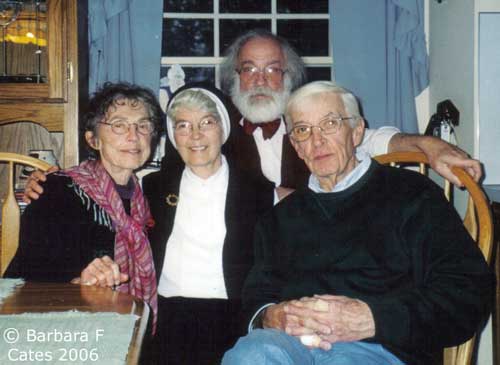
John and Mary Stremba's grown children, just outside Reading, Pennsylvania, 26 December 2005, from left to right: Theresa, Rita (Elaine), Matthew, John.
MY SISTER'S VERSION
My brother's escapade with the truck, my sister says, took place earlier than I had imagined. She insists John was much younger, not much beyond ten, because, as she remembers it, he had to stand to see over the steering wheel. Further, she is sure just how old she herself was in the midst of this story's mounting action. As incredible as this sounds, who can argue with such an on-site witness? And so I append details from Theresa's point of view, which not only add to, but, in effect, also edit the story above.
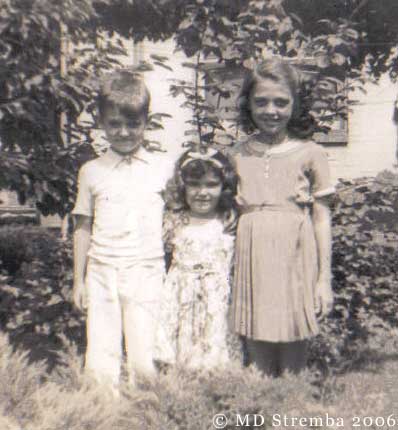
Left to right, John, Elaine, Theresa, 1941, before my birth, and a year or two or three before John's escapade with the truck. Backyard garden, view toward the Farina house; behind the person snapping the picture with a box camera (probably Mom) is the Kostival house.
In this plot-line, where was Theresa physically? They were all outside in front of our house: Theresa, John and their youngest sister, Elaine—all three sibs ready to set out on the ice-errand pulling that wagon. I can almost picture them lined up in 1940s' black-and-white. It was just then little John got the inspiration to make use of the truck. The key was in the ignition, not on the table inside—an ordinary practice in those golden days, Theresa reminds me. She remembers quickly assuming the role of the wiser older sister, trying to dissuade her brother, then soon being conflicted as he proceeded doing it his way along with a co-adventurer, one of the next-door neighbor's boys (the Kostivals had seven). Should she run in and warn Mom and get little John in hot water? or keep mum and pray God to bring the adventurer back safely before Mom or Dad saw the truck was gone?

Theresa, a bit more the young lady, holding the newest Stremba, and Elaine and John, 1942, which may be the year of the ice-errand by truck; or maybe the following summer.
Theresa remembers chasing after the truck running down Bingaman, down Minor, down to Laurel, then breathlessly watching it laboriously climb the hill towards Ninth. Omigod, she thought suddenly, what's Elaine doing back there in front the house? Has her little sister gone inside to update Mom on all the latest developments. She sprinted back, rounded the corner from Minor onto Bingaman and, out of breath, spied Elaine still standing there with the wagon. Good girl! But what if Mom just happens to look out and wonders why Elaine is there all by herself? Hadn't the children one off for the ice yet? Theresa joined Elaine there with the wagon, fretting: please, Lord, don't let him wreck the truck and kill himself, and do keep Mom in the kitchen. It seemed an eternity before they saw the truck turn onto Bingaman and slowly coast to a shuddering halt in front of the house—John practically standing on the brake; Georgie, a co-pilot without a seat, laughing wide-eyed at the accomplishment.
Dad did know something, Theresa affirms. For John Jr. could not park the truck in its original spot, just got it to the curb as best he could on the OTHER side of the street. Just seconds before Dad came out to return to work, little John had yanked the block of ice out of the truck and into the wagon. Theresa remembers Dad's solemn double-take as if to ask: ''How did the truck get to this side of the street?'' But, after that dramatic pause, he said nothing. Nor did they. Till it was time to tell the story.
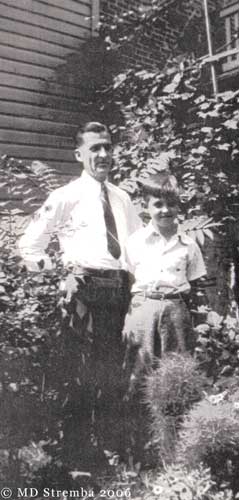
Dad with oldest son, 1942. Is the truck caper in the past, or yet to come?
And that, of course is what I'd depended on—the story as I remembered hearing it oft retold. I had consulted with John, because it is his story, but he paid less attention to his role, wanting rather to enumerate more background details: Dad's other jobs, the oddities of this or that neighbor, nearby commercial establishments. I just never thought to check with the other sib-witnesses. Bear that in mind as you do your family stories—different sources, other details.
LAST WORD.
We've long prized this story from our family treasury. Though my brother John might have chosen to make surreptitious use of Delp's truck on almost any errand that was usually done on foot, oddly it's getting that block of ice for the icebox that makes this really special for me.
Recalling it some months ago I began asking around whether any of my friends have memories of family stories featuring somehow an icebox. One guy, older than I, incredibly claimed his folks never had an icebox. Yet others have indeed some great pre-refrigeration stories, even promising me photographs. So, in trembling and sweat before the scourge of a July-August scorcher, I've posted on this web-site such an anthology of friends' ice-box stories, clippings, factoids and trivia. Stuff to keep cool by. Without cost. Don't miss it. If you've got any more good ones to share, let me know and I'll consider it for the sequel (with full attribution, of course).
Incidentally, about that market-house where young John earned a few dimes— built at Bingaman and South Sixth Streets in the 19th century—in the last years of the 20th it sat big, dark and empty, long out of use, waiting on some high-level decision what to do with this historic property. Just last year someone torched it. Wrecking crews had to finish the destruction. It lives now only in the lore.